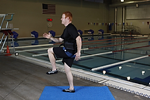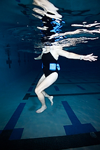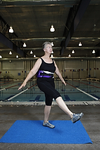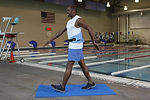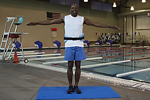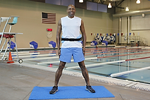Can you do the same exercises in deep water that you can do in shallow water? You can do some of them, but not all, and there are some exercises that you can do in deep water that you can’t do in shallow. When you are building your exercise library for deep water, remember that there are only a few basic exercises and all other exercises are variations of these.
The basic exercises in deep water are jog, bicycle, kick, cross-country ski and jumping jacks. If you do the jumping jacks with the arms and legs opposite, as shown in the start and finish photos, then you will not bob up and down.
Just as in shallow water, there are many ways to vary these 5 exercises.
- Use different arm movements. Try arm swing (shoulder flexion and extension), lat pull-down (shoulder abduction and adduction), shoulder sweep (horizontal shoulder abduction and adduction), arm curls (elbow flexion and extension), or rotator cuff sweep (shoulder external and internal rotation). Use alternating arms or both arms in unison. If you use one arm, or no arms, you will challenge your core muscles, because it will be harder to maintain neutral posture.
- Vary the tempo. The speed at which exercises are performed in deep water is slower than in shallow water because the range of motion is greater. But you can still vary the tempo with pauses (single, single, hold) or syncopate (slow, slow, quick, quick, quick). You can also increase the speed, especially with smaller moves such as flutter kick, mini ski and mini jacks.
- Change the working position. Exercises can be performed upright, at a diagonal angle, side-lying, or seated. Use a scull to lift the shoulders out of the water.
- Increase the range of motion. Exercises can be performed with larger arm or leg movements, or the feet farther apart, or you can cross the midline of the body.
- Add acceleration or power, by pushing harder against the resistance of the water. If you accelerate toward center in what is sometimes called a power pop, you can lift and lower the shoulders in and out of the water in a very high intensity move.
- Add turns. You can do quarter turns, half turns, or full turns. Diagonal turns are quarter turns toward the right corner, then toward the left corner.
- Travel. You can travel forward, backward, and sideways. Although you can travel using leg motions only, most travel in deep water depends on arm movements. If you lean diagonally toward the side, you will travel sideways. If you are in a side-lying position, it will be the leg movements that propel you sideways. You can travel in patterns, such as a diagonal line, circle, square, bow-tie pattern, zig-zag, or scatter pattern.
- Combine exercises. Putting two or more exercises together creates a new exercise. Examples include log jump right, jacks tuck, log jump left; quad kick front and side; tuck ski and jacks tuck alternate; and cross-country ski side-lying right, tuck, pike, tuck, cross-country ski side-lying left.
Not every variation will work with every exercise. But using even a few variations will increase your exercise library tremendously.
Note: the photos are from my book, Water Fitness lesson Plans and Choreography. For more information on the book, check out my website at www.waterfitnesslessons.com

